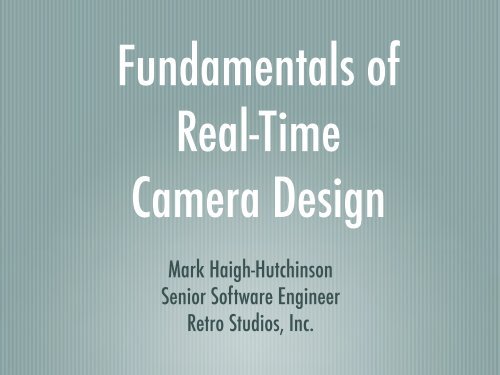Mark Haigh-Hutchinson Senior Software Engineer Retro Studios, Inc.
Mark Haigh-Hutchinson Senior Software Engineer Retro Studios, Inc.
Mark Haigh-Hutchinson Senior Software Engineer Retro Studios, Inc.
You also want an ePaper? Increase the reach of your titles
YUMPU automatically turns print PDFs into web optimized ePapers that Google loves.
Fundamentals of<br />
Real-Time<br />
Camera Design<br />
<strong>Mark</strong> <strong>Haigh</strong>-<strong>Hutchinson</strong><br />
<strong>Senior</strong> <strong>Software</strong> <strong>Engineer</strong><br />
<strong>Retro</strong> <strong>Studios</strong>, <strong>Inc</strong>.
<strong>Mark</strong> <strong>Haigh</strong>-<strong>Hutchinson</strong><br />
21 years in the games industry<br />
40+ published titles<br />
Programmer / Designer / Project Leader<br />
Camera systems and player controls<br />
Metroid Prime<br />
Metroid Prime 2:Echoes
Agenda<br />
Why talk about camera design?<br />
To raise awareness<br />
Avoidable camera problems persist<br />
Small amount of literature<br />
Set a high standard
Topics<br />
Camera System Overview<br />
Camera Fundamentals<br />
Game Genre Cameras<br />
Camera Design Principles<br />
Player Control<br />
Camera Design Process<br />
Camera Design Questions
Camera System<br />
Overview
Camera System Overview<br />
Controls game presentation<br />
Defines main interface of game<br />
Real-time and cinematic sequences<br />
Services other game systems<br />
Uses general and specific solutions<br />
Allows designers to override behaviors
Camera System Goals<br />
Present best view of game play<br />
Avoid player frustration<br />
Be unobtrusive<br />
Prevent disorientation<br />
Allow player control as appropriate
Camera Fundamentals
Camera Fundamentals<br />
What do we mean by a camera?<br />
Defines a view of the game world<br />
Does not usually simulate real camera properties<br />
Many different types of cameras<br />
Cinematic or Interactive
Camera Types<br />
Cinematic Interactive<br />
Pre-defined behavior<br />
Aesthetics over game play<br />
Established conventions<br />
Well-defined situations<br />
Dynamic behavior<br />
Game play over aesthetics<br />
Conventions being defined<br />
Wide variety of situations
Camera Properties<br />
Presentation style (Projection)<br />
Type (First, Third person)<br />
Behavior<br />
Desired position<br />
Motion type<br />
Look-At position<br />
Orientation method
First Person Camera<br />
Viewed from player<br />
Limited Field-Of-View<br />
Positioning is difficult<br />
Aiming is easy<br />
Limited character view<br />
Very immersive
Third Person Camera<br />
External to player<br />
Positioning easier<br />
Aiming more difficult<br />
Less immersive<br />
Navigation problems<br />
Framing problems
Camera Motion<br />
Desired position<br />
Motion types<br />
Stationary<br />
Slaved<br />
Path constrained<br />
Surface constrained<br />
Motion method
Camera Orientation<br />
Look-At position<br />
Object tracking<br />
Object framing<br />
Path tracking<br />
Orientation lag<br />
Free-look
Game Genre Cameras<br />
Part 1
Game Genre Cameras<br />
Genre-specific camera types<br />
Game play requirements more important<br />
Multiple camera types often required<br />
Split-screen multi-player presents additional challenges
Action-Adventure<br />
Motion and orientation lag<br />
Elevated position<br />
Look-at depends on action<br />
Generalized solution difficult<br />
Minimize reorientation
3D Platform<br />
Elevated position<br />
Often pre-defined path or position<br />
Environment view most important<br />
User control override preferred
Flight Simulation<br />
Requires multiple viewpoints<br />
Roll is permissible<br />
Look-at position ahead of craft<br />
Replay cameras
Racing<br />
Multiple viewpoints<br />
Defined camera paths<br />
Motion and orientation lag<br />
Replay cameras
Camera Design<br />
Principles
Camera Design Principles<br />
Avoid player character occlusion<br />
Navigate environment automatically<br />
Allow camera manipulation<br />
Do not REQUIRE camera manipulation<br />
Minimize camera motion<br />
Ensure motion is smooth
Camera Design Principles<br />
Limit reorientation speed<br />
Limit use of roll<br />
Lead a character in motion<br />
Preserve player intent<br />
Seamless transitions
Player Control
Player Control<br />
Linked to camera system<br />
Genre & controller dependent<br />
Consistency of control<br />
Can be automated<br />
Abstracted to commands<br />
Control Reference Frame
Control Reference Frame<br />
Maps player controls to character motion<br />
Abrupt changes frustrate<br />
Retain after instant or rapid motion<br />
Game play and genre dependent
Control Reference Frame<br />
Character-relative : Problematic in third person<br />
Camera-relative : Player proximity issues<br />
World-relative : Controls are consistent<br />
Screen-relative : Motion defined by camera view<br />
Object-relative : Inscribes a motion arc (”lock-on”)
Game Genre Cameras<br />
Part 2
Game Genre Cameras<br />
Camera choice can be difficult<br />
Player perception linked to camera type<br />
Not restricted to “traditional” choices<br />
Experimentation is encouraged
Fighting<br />
Must frame multiple characters<br />
Focal point between enemies<br />
Open environments<br />
Cinematic approach
Role Playing Games<br />
Elevated, distant position<br />
Often entirely user controlled<br />
Combat may use stationary view<br />
Navigation difficulties
Sports<br />
Matches TV presentation style<br />
Multiple viewpoints<br />
Elevated positions mostly<br />
Replay cameras
Camera Design<br />
Process
Camera Design Process<br />
Important part of entire game design<br />
Requires dedicated staff<br />
Prototype and iterate early<br />
Derive from game play and environments
Camera Design Process<br />
Overview<br />
Examine high level design goals<br />
Evaluate player character abilities<br />
Determine scope of environments<br />
Define base camera behavior(s)<br />
Determine area-specific requirements<br />
Technical evaluation of cameras
Camera Design Process<br />
Per Area<br />
Determine specific environment needs<br />
Specify game play / AI / game objects<br />
Prototype simplest solution<br />
Refine once game play fixed
Camera Design<br />
Questions
Camera Design Questions<br />
Player Abilities and Controls<br />
Consider all character movement properties<br />
Has the motion been finalized?<br />
Any ranged interactions?<br />
Do the player abilities change over time?<br />
Are control changes necessary?<br />
Simplify or restrict controls?<br />
Camera manipulation allowed?
Camera Design Questions<br />
Environmental Concerns<br />
Sufficient space for camera motion / framing?<br />
Single presentation style?<br />
Will interpolation methods work?<br />
Removal or fading possible to avoid occlusion?
Camera Design Questions<br />
Aesthetics<br />
Character framing?<br />
Aiming or ranged interactions?<br />
Is orientation or motion lag required?<br />
Does occlusion matter?<br />
Pre-defined or dynamic positioning?
Camera Design Questions<br />
Technical considerations<br />
Object or geometry transparency?<br />
Rendering issues outside world<br />
Dynamic camera behaviors?<br />
Camera specific collision detection & avoidance?<br />
Tools to specify camera behaviors<br />
Camera debugging facilities?
Conclusions
Conclusions<br />
Camera design greatly impacts game play<br />
Essential part of the overall game design task<br />
Requires dedicated development staff<br />
Player control linked to camera design<br />
No single camera solution<br />
Prototype early and design away problems<br />
Successful camera systems are unobtrusive
Conclusions<br />
No-one will notice if you truly succeed
Further Reading
Further Reading<br />
Game Programming Gems Series, Volumes 1, 2, & 4<br />
AI Game Programming Wisdom Series, Volumes 1 & 2<br />
Real-Time Cinematography for Games - Brian Hawkins<br />
GDC 2004 Proceedings<br />
Full Spectrum Warrior Camera System - John Giors<br />
Grammar of the Film Language - Daniel Arijon
Forthcoming Book<br />
Real-Time Cameras<br />
Written by <strong>Mark</strong> <strong>Haigh</strong>-<strong>Hutchinson</strong><br />
Published by Morgan Kaufmann<br />
Series in Interactive 3D Technology<br />
www.mkp.com<br />
www.realtimecameras.com
One Last Thing...
Thanks!<br />
GDC 2005 Selection Committee<br />
John Giors, Ryan Harris, Akintunde Omitowoju, Kynan Pearson
Contact Info<br />
mhh@computer.org<br />
www.realtimecameras.com



